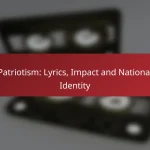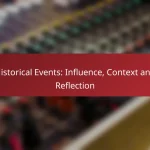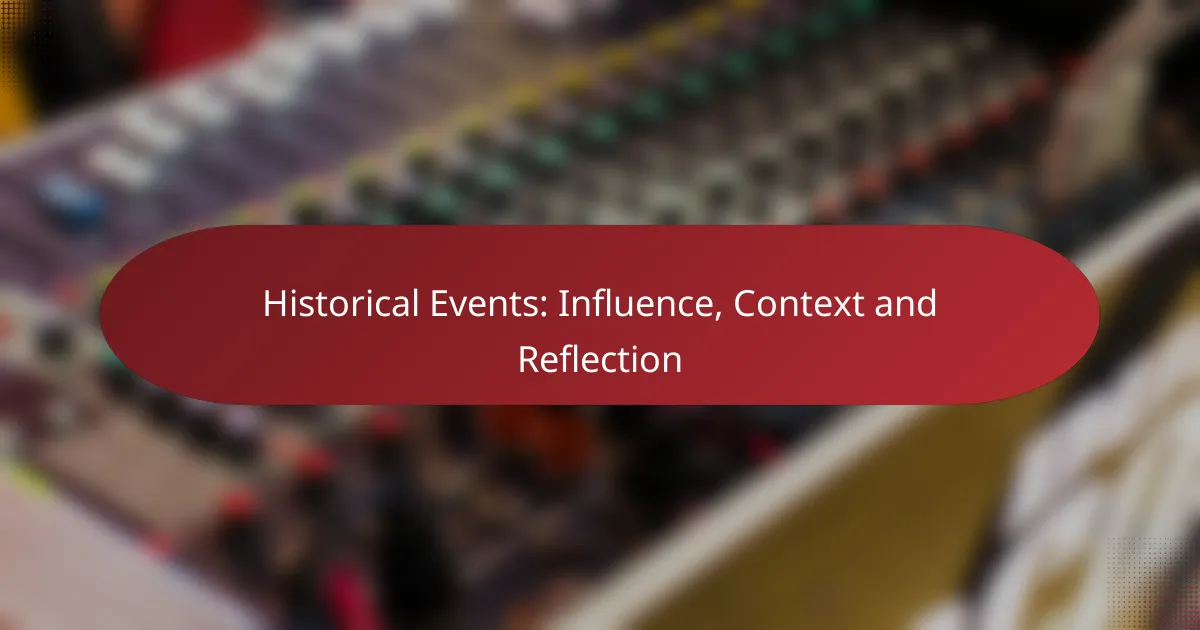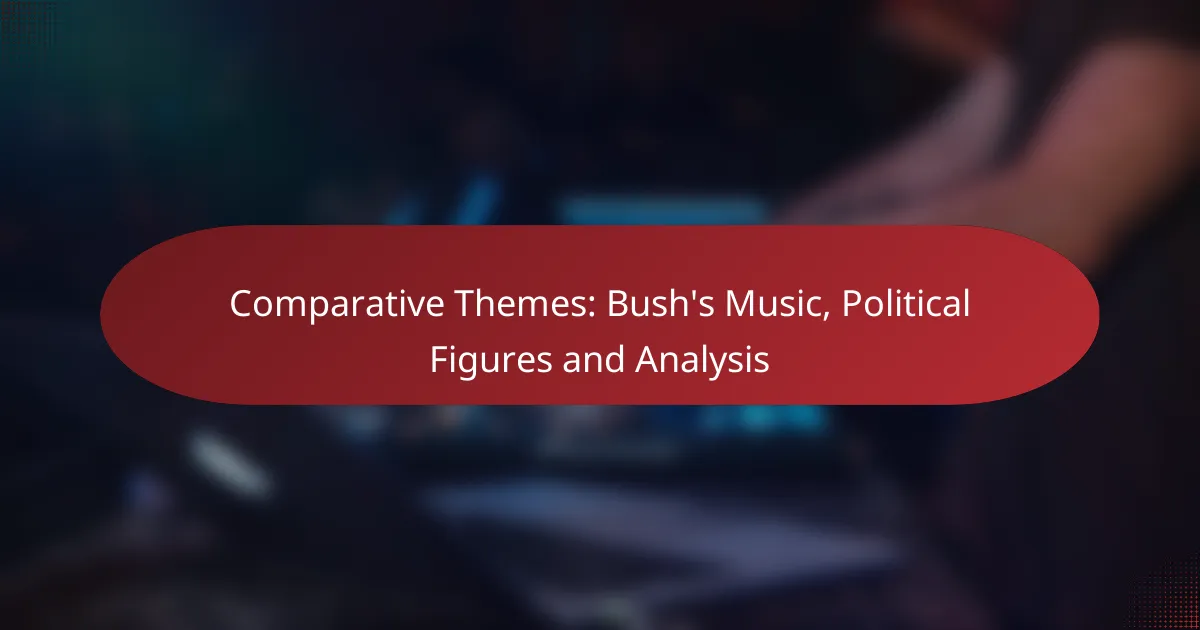Historical events play a crucial role in shaping the cultural, political, and economic landscape of modern society. By examining these events and their contexts, we gain valuable insights into human behavior and the structures that govern our lives, allowing us to better understand contemporary issues and their roots. This reflection on the past equips us with lessons that can guide our future decisions and actions.
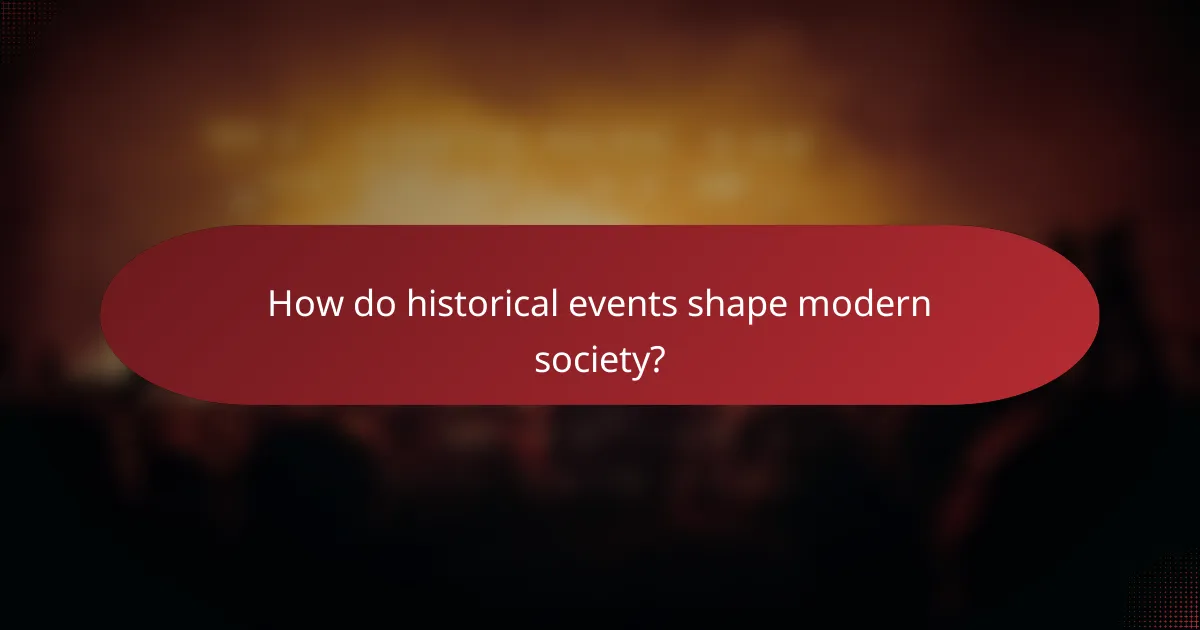
How do historical events shape modern society?
Historical events significantly influence modern society by shaping cultural identities, political systems, and economic development. Understanding these impacts helps us navigate contemporary issues and appreciate the roots of current societal structures.
Influence on cultural identity
Historical events play a crucial role in forming cultural identities by creating shared narratives and collective memories. For instance, the legacy of colonialism continues to affect the cultural identities of many nations, influencing language, traditions, and social norms.
Moreover, significant events like revolutions or independence movements foster a sense of unity and pride among people, often leading to the celebration of national holidays and the preservation of cultural heritage. These influences can be seen in festivals, art, and literature that reflect historical struggles and triumphs.
Impact on political systems
Historical events directly shape political systems by establishing governance structures and influencing ideologies. For example, the aftermath of World War II led to the establishment of democratic governments in many European countries, while others experienced the rise of authoritarian regimes.
Additionally, historical conflicts often result in the creation of new political boundaries and alliances, which can redefine power dynamics. The Cold War, for instance, established a bipolar world order that continues to influence international relations today.
Role in economic development
Economic development is often a byproduct of historical events that shape trade relationships and resource distribution. The Industrial Revolution, for example, transformed economies from agrarian to industrial, leading to urbanization and changes in labor markets.
Furthermore, historical events such as wars or economic crises can lead to significant shifts in economic policies. Countries recovering from conflict often implement reforms to stimulate growth, which can result in long-term economic changes.
Examples from World War II
World War II serves as a pivotal example of how historical events shape modern society. The war led to the establishment of the United Nations, aimed at promoting international cooperation and preventing future conflicts.
Additionally, the economic recovery plans, such as the Marshall Plan, significantly influenced the economic landscape of Europe, fostering growth and stability. The social changes that emerged, including movements for civil rights and decolonization, continue to resonate in contemporary society.

What lessons can we learn from historical events?
Historical events provide valuable insights into human behavior, societal structures, and the consequences of actions. By analyzing these events, we can derive lessons that inform our decisions and actions today.
Understanding conflict resolution
Historical conflicts often reveal effective strategies for resolving disputes. Key lessons include the importance of dialogue, negotiation, and compromise. For instance, the peace treaties that ended major wars demonstrate how addressing underlying grievances can lead to lasting solutions.
To apply these lessons, consider establishing open communication channels in your community or organization. Encourage all parties to express their concerns and work collaboratively towards a resolution. Avoiding escalation through mediation can often yield better outcomes than confrontation.
Promoting social justice
Many historical movements for social justice highlight the need for equity and inclusion. Events such as the Civil Rights Movement in the United States showcase how collective action can challenge systemic injustices. These movements teach us the importance of advocacy and solidarity in achieving social change.
To promote social justice today, engage with local organizations that focus on equity issues. Support initiatives that aim to dismantle discriminatory practices and policies. Understanding the historical context of these struggles can empower individuals to contribute meaningfully to ongoing efforts.
Encouraging civic engagement
Historical events often underscore the significance of civic engagement in shaping society. The suffrage movements around the world illustrate how active participation in governance can lead to transformative change. These examples remind us that informed citizens are crucial for a healthy democracy.
To foster civic engagement, encourage participation in local elections and community meetings. Educate yourself and others about the issues at stake and the importance of voting. Simple actions, like discussing civic responsibilities with peers, can inspire greater involvement in public affairs.
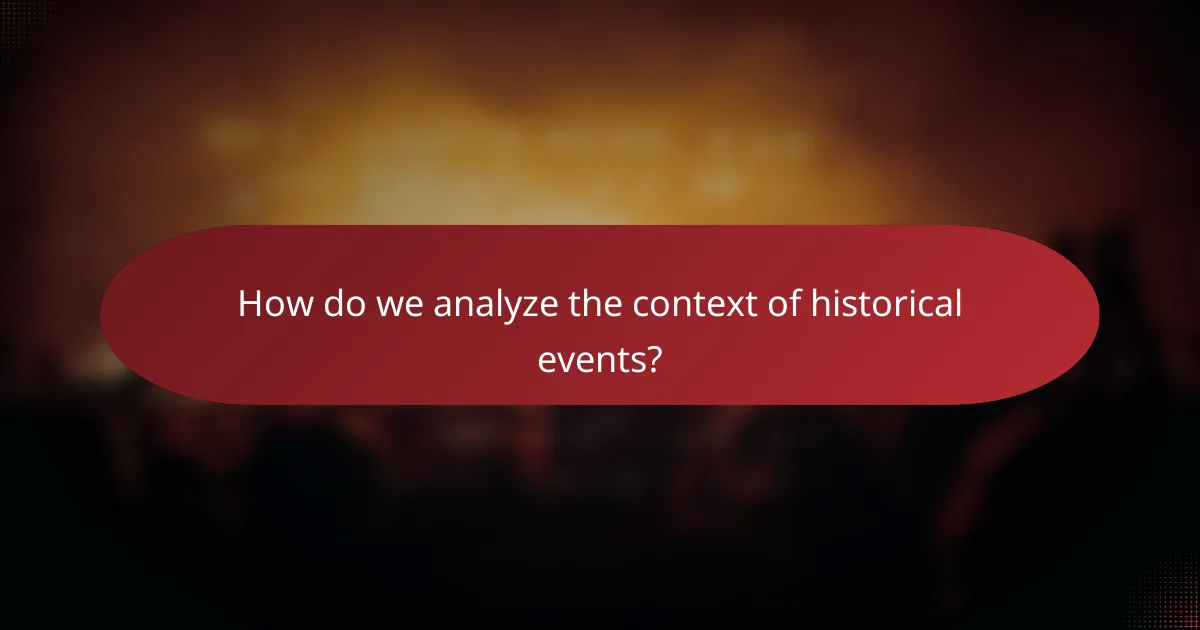
How do we analyze the context of historical events?
Analyzing the context of historical events involves examining the social, political, economic, and cultural factors that influenced those events. This process helps to understand not only what happened but also why it happened and its implications for the future.
Importance of primary sources
Primary sources are original documents or artifacts created during the time under study, such as letters, photographs, and official records. They provide firsthand accounts and direct evidence of historical events, allowing researchers to gain insights into the perspectives and experiences of those who lived through them.
When analyzing primary sources, consider their origin, purpose, and audience. For example, a soldier’s diary may reveal personal emotions and experiences, while a government report might reflect official narratives and policies. Always evaluate the reliability and bias of these sources to draw accurate conclusions.
Role of historiography
Historiography is the study of how history is written and interpreted over time. It examines the different perspectives historians have taken regarding specific events and the methodologies they employed. Understanding historiography allows researchers to recognize how interpretations can change based on new evidence or shifts in societal values.
When analyzing historiography, consider the context in which historians wrote their works. For instance, interpretations of World War II may vary significantly between historians from different countries or ideological backgrounds. This awareness helps to critically assess historical narratives and their implications.
Influence of geography
Geography plays a crucial role in shaping historical events by influencing resources, trade routes, and cultural interactions. The physical landscape can determine the development of civilizations, the outcomes of conflicts, and the spread of ideas. For example, mountain ranges may isolate communities, while rivers can facilitate trade and communication.
When analyzing the influence of geography, consider how location affected the social and economic structures of societies. The availability of natural resources, climate conditions, and proximity to other cultures can significantly impact historical trajectories. Understanding these geographical factors provides a deeper context for historical events and their outcomes.
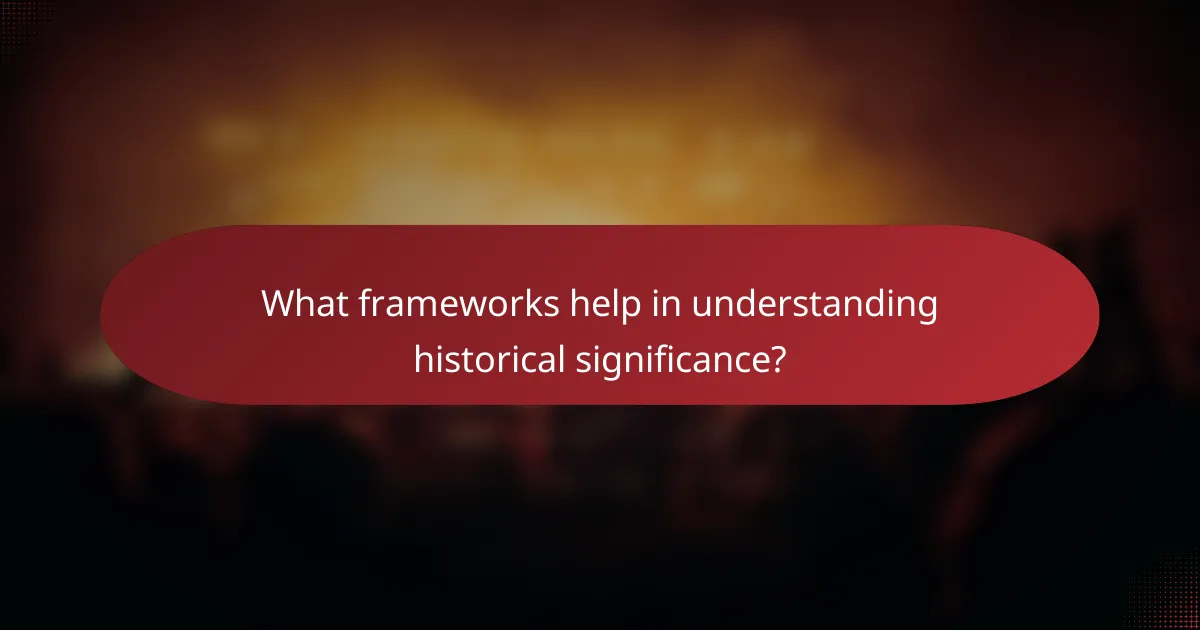
What frameworks help in understanding historical significance?
To grasp historical significance, frameworks like chronological frameworks and thematic analysis are essential. These tools help in organizing events and understanding their broader implications within specific contexts.
Chronological frameworks
Chronological frameworks involve organizing historical events in the order they occurred. This method allows for a clear timeline that highlights cause-and-effect relationships and the progression of events over time.
When using chronological frameworks, consider key dates, significant milestones, and the duration of events. For example, the timeline of World War II can be segmented into pre-war, wartime, and post-war periods, each with distinct influences on global politics.
Be cautious of oversimplifying complex events into a linear timeline. Some events may overlap or influence each other in non-linear ways, so it’s important to recognize these interactions.
Thematic analysis
Thematic analysis focuses on identifying and exploring key themes or patterns across historical events rather than just their chronological order. This approach allows for a deeper understanding of the underlying issues that shaped history.
For instance, examining the theme of colonialism can reveal its impact on various regions over centuries, highlighting similarities and differences in experiences. This method encourages connections between seemingly disparate events, such as the American Revolution and the Haitian Revolution, both influenced by Enlightenment ideas.
When conducting thematic analysis, ensure you define your themes clearly and support them with relevant historical evidence. Avoid cherry-picking examples that only fit your narrative; instead, strive for a balanced view that acknowledges multiple perspectives.
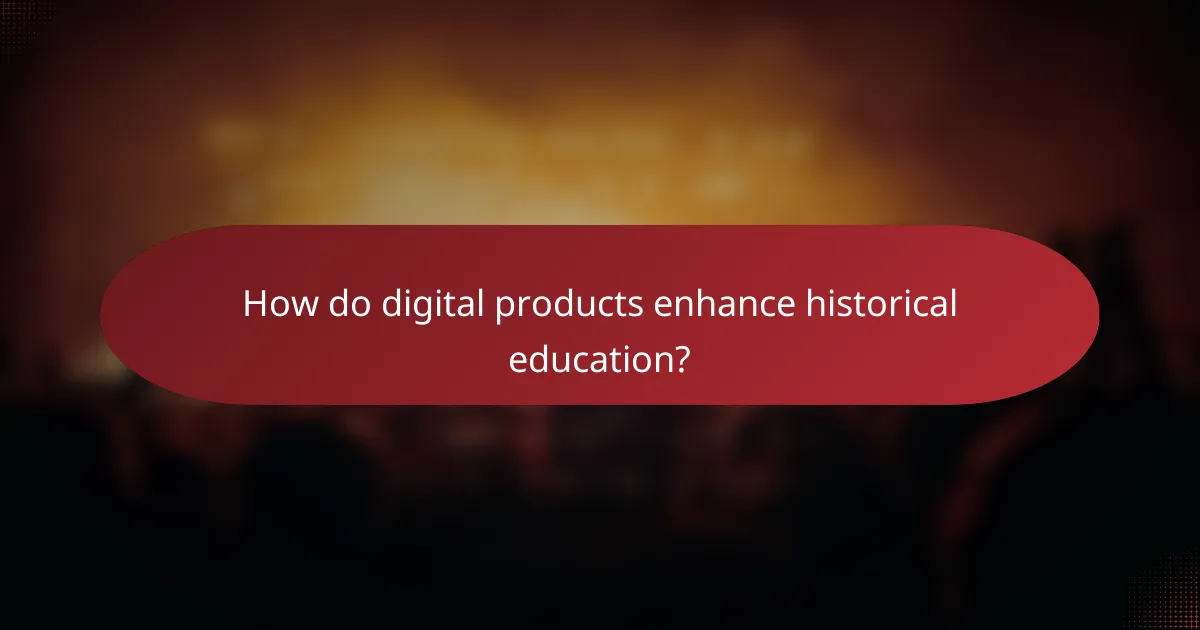
How do digital products enhance historical education?
Digital products significantly enhance historical education by providing interactive and immersive experiences that engage learners. These tools allow users to explore historical events in dynamic ways, making the learning process more effective and enjoyable.
Interactive timelines
Interactive timelines present historical events in a visual format, allowing users to see the chronological relationships between different occurrences. They often include multimedia elements like images, videos, and audio clips that enrich the narrative.
When creating or using interactive timelines, consider platforms that allow customization and user engagement. For example, tools like Tiki-Toki or TimelineJS enable educators to create timelines that can be tailored to specific topics or themes.
Virtual reality experiences
Virtual reality (VR) experiences immerse users in historical settings, providing a first-person perspective of significant events. This technology can transport learners to ancient civilizations or pivotal moments in history, offering a deeper understanding of context and culture.
To effectively utilize VR in historical education, ensure access to appropriate hardware and software, as well as content that aligns with educational goals. Experiences like “The VR Museum of Fine Art” or “TimeLooper” can serve as valuable resources for educators.
Online courses and resources
Online courses and resources offer structured learning paths that cover various historical topics, often featuring expert instructors and comprehensive materials. Platforms like Coursera or edX provide access to courses from renowned institutions, making quality education widely available.
When selecting online courses, look for those that include interactive elements, such as quizzes or discussion forums, to enhance engagement. Additionally, consider resources that offer downloadable materials for offline study, ensuring flexibility in learning.
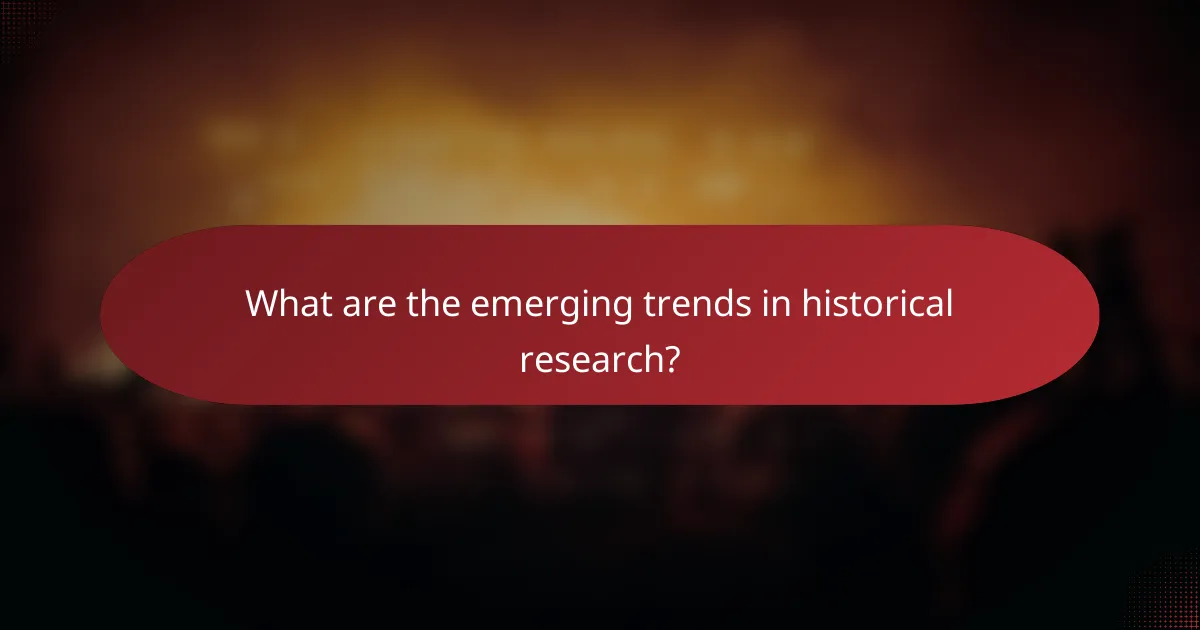
What are the emerging trends in historical research?
Emerging trends in historical research include the integration of technology, interdisciplinary approaches, and a focus on diverse narratives. These trends are reshaping how historians gather, analyze, and interpret data, leading to richer insights and broader perspectives.
Use of big data analytics
Big data analytics is increasingly utilized in historical research to process vast amounts of information from various sources. This approach allows historians to uncover patterns and trends that traditional methods might miss, enhancing the depth of historical analysis.
Historians can leverage big data tools to analyze texts, images, and even social media posts, providing a more comprehensive view of historical events. For example, analyzing digitized newspapers can reveal public sentiment during significant events, offering insights into societal attitudes.
When employing big data analytics, researchers should consider data quality and relevance. It’s essential to ensure that the sources used are credible and representative to avoid skewed interpretations. Additionally, balancing quantitative data with qualitative insights can lead to more nuanced conclusions.

